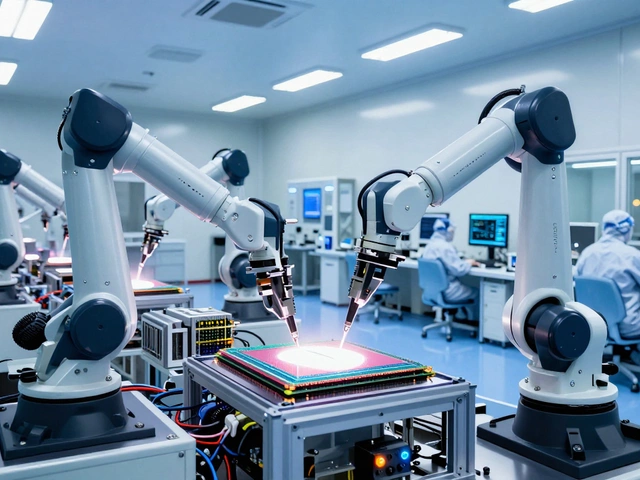Can the US Economy Thrive Without a Robust Manufacturing Base?

The US has long been hailed for its diverse economy, but recent shifts have sparked debates on whether it can continue to grow without leaning heavily on manufacturing. It's not just a question of jobs or factory outputs; it's about understanding where the real potential for economic growth lies.
For decades, manufacturing was the engine that powered the American dream. However, over the years, the focus has shifted towards the service sector and tech innovation. While these sectors are booming, the void left by manufacturing raises concerns. Many argue that a country without a strong manufacturing base misses out on certain economic stability benefits.
Government schemes have tried to tackle this transition. From tax incentives for manufacturers to trade policies aimed at making American products competitive on a global scale, these efforts show varying degrees of success. So, what does this mean for the everyday worker or small business owner? Understanding these policies might give insights into where opportunities and challenges lie.
- The Changing Face of US Manufacturing
- Government Schemes & Policies
- Globalization's Impact
- The Role of Technology
- Lessons from Other Economies
- Future Prospects for US Economy
The Changing Face of US Manufacturing
There's no denying that US manufacturing isn't what it used to be. In fact, it's undergone quite the transformation, adjusting to a world that's more interconnected than ever. But what exactly changed, and why does it matter?
Global competition and the push towards cheaper production options have gotten lots of attention. Many industries saw jobs move overseas, where labor costs are lower. This caused a dip in traditional manufacturing jobs, leading to a shift in focus for the American workforce.
Automation and Advanced Technologies
Just as global competition altered the landscape, technology stepped in to change the game. Automation and robotics are no longer future prospects; they’re current realities. Today, factories are more about tech than mere manpower. With automation, the need for physical labor decreased, but interestingly, tech roles surged. This new face of manufacturing requires a highly skilled workforce—people who can manage, program, and maintain machines.
Economic Output vs. Employment
Here's an interesting fact: while manufacturing jobs declined, overall output didn’t. In some sectors, it even grew. The U.S. is still a world leader in manufacturing output, thanks to increased productivity and technology integration. It signals a shift from quantity (jobs) to quality (high-value products), changing what it means to support the economy.
Policy Impact
The role of policy can't be ignored here. Government schemes aimed at bolstering manufacturing are mostly about creating competitive advantages. Initiatives like tax incentives, grants for research and development, and free trade zones are designed to make American manufacturing appealing again.
| Year | Manufacturing Jobs (in millions) | Manufacturing Output (in trillions) |
|---|---|---|
| 2000 | 17.3 | 1.76 |
| 2020 | 12.1 | 2.35 |
As you can see, while manufacturing jobs dipped over the years, output rose significantly, indicating the efficiency improvements and economic shifts within the sector.
The heart of the matter is clear: the US economy is dealing with a lot of changes. Whether these become opportunities or challenges depends largely on how adaptable industries and workers can be in the face of rapid advancements.
Government Schemes & Policies
Now, let's get into the nitty-gritty of what the government is doing with its economic strategies. US economy relies on smart policies to navigate these uncertain waters. There are a bunch of schemes aimed at boosting the manufacturing sector, making sure that it remains a viable part of our GDP.
Incentives for Innovation
First off, the US government has rolled out tax cuts and credits for companies that invest in research and development. It's called the R&D Tax Credit program. Companies taking part in this program can reclaim a portion of their expenses on developing new or improved products and processes. Pretty neat, right?
Trade Adjustments
With globalization pulling the strings, the Trade Adjustment Assistance (TAA) program helps workers who have lost jobs due to foreign trade. It provides them with training, reemployment services, and health care subsidies to help them find new gigs. It might not solve everything, but it's a start.
Promoting 'Made in America'
The 'Made in America' initiative encourages consumers to buy products manufactured within the country. This includes federal policies requiring government agencies to buy American-made goods. The goal is to create a ripple effect that supports domestic manufacturers and boosts the local economy.
New Infrastructure Bill
This new piece of legislation allocates substantial funds toward upgrading America's infrastructure. By focusing on local sourcing of materials and talent, it dovetails nicely with efforts to give the manufacturing industry a shot in the arm. Local businesses may find new opportunities opening up as a result.
If you're running a business or thinking about starting one, these policies and schemes are worth keeping an eye on. They could play a crucial role in your decision-making and might even offer unexpected advantages. Plus, as more of these initiatives roll out over time, they may change the landscape in ways we haven't yet imagined.
Globalization's Impact
When it comes to globalization, it has truly reshaped the landscape of the US economy and its manufacturing sector. We're talking about a world where boundaries are more about Wi-Fi signals than actual borders. And with this, things have changed - both for better and for worse.
The Outsourcing Phenomenon
One of the biggest shifts occurred when companies discovered they could produce goods cheaper overseas. By outsourcing manufacturing to countries with lower labor costs, American companies could cut expenses and, in theory, pass those savings onto consumers. This led to a boom in international trade but also resulted in factory closures at home and a decline in manufacturing jobs.
Competing on a Global Stage
With globalization, the competition is fierce. American manufacturers are not just competing with the next state over; they're up against countries that might have entirely different economic environments. This has pushed the industry to innovate, but it also means staying on top of cutting-edge tech and efficiency practices.
Trade Agreements and Policies
The US has entered numerous trade agreements, aiming to make it easier for its products to be sold worldwide. However, these agreements can sometimes be a double-edged sword. While they open doors to new markets, they also allow foreign products to flood US markets, often at much lower prices. This challenges American manufacturers to maintain competitiveness without losing quality.
The Story in Numbers
Here's a look at how the global stage has influenced US manufacturing over the years:
| Year | Manufacturing Jobs (Millions) | Import Growth (%) |
|---|---|---|
| 2000 | 17.3 | 5.5 |
| 2010 | 11.5 | 12.4 |
| 2020 | 12.3 | 9.8 |
This table shows how jobs took a hit even as imports kept growing. These numbers tell a story of dependency on foreign goods and highlight challenges in reviving domestic manufacturing.
So, what's the takeaway? While globalization has created opportunities for growth and efficiency, it's also posed significant challenges for the US's ability to maintain a big manufacturing base. Understanding these dynamics is crucial for any policy aimed at fostering economic resilience.

The Role of Technology
Technology is the game-changer in today's economy, especially in terms of how it interacts with the US economy and manufacturing. We've seen a significant shift in how products are made and delivered, thanks to new tech like robotics, artificial intelligence, and the Internet of Things (IoT).
One prominent example is automation. Factories are using advanced robotics to increase efficiency, reduce costs, and in some cases, bring manufacturing back to the US. These machines can work longer hours without breaks, making production lines highly efficient.
AI and Big Data
Artificial Intelligence (AI) plays a huge part too. In manufacturing, AI helps in predicting equipment failures before they happen and in designing more efficient production processes. This reduces downtime and improves product quality, which is a big plus for a competitive market.
Consider Big Data analytics—companies now dive into huge sets of data to optimize their operations. Imagine analyzing patterns from millions of data points to make informed decisions. This wasn't possible a couple of decades ago.
3D Printing and Customization
Another technology shaking things up is 3D printing, allowing firms to produce complex, customized goods directly from digital models. This makes personalized products much easier and quicker to produce, which can help smaller businesses compete with the giants in the market.
In 2023, it was reported that the value of the global 3D printing market reached approximately $17.4 billion. This demonstrates just how far this technology has come and its potential impact on manufacturing.
Remote Monitoring through IoT
The IoT is another exciting development. It allows for remote monitoring of factory equipment, ensuring everything runs smoothly and reducing the need for on-site staff intervention. It’s like having a smart home, but on an industrial scale!
Technology keeps the US competitive on a global stage, even if its traditional manufacturing role has shifted. By embracing these advancements, the country can maintain robust economic growth without necessarily returning to a heavy reliance on manufacturing.
Lessons from Other Economies
Looking at how different countries handle manufacturing gives us a bunch of insights. Some nations have managed to thrive without being manufacturing giants, while others have stuck to their manufacturing roots and achieved substantial growth.
Germany: Engineering Excellence
Germany stands out as a powerhouse because of its focus on precision engineering and high-quality manufacturing. While manufacturing makes up a substantial part of its economy, Germany combines this with strong education and vocational training, ensuring their workforce is skilled. This focus on quality over quantity sets an example in maintaining a competitive edge globally.
Singapore: A Service-centric Approach
Singapore, on the other hand, proves that a country can excel with a service-oriented economy. With limited land and resources, Singapore invested in becoming a financial and tech hub. Its low tax rates and business-friendly environment attract multinationals. This shift from traditional manufacturing helps show that adapting to strengths can lead a nation to success.
China: Manufacturing Giants
China's economic boom is deeply rooted in its manufacturing capabilities. By focusing on mass production and leveraging lower labor costs, China transformed into the 'world's factory.' However, the country is now investing more in technology and innovation to sustain this growth long-term.
Looking North: Canada
Canada might not be the first country that comes to mind for manufacturing, but its strategic investments in both natural resources and tech sectors offer valuable insights. Balancing between these industries allows Canada to maintain a stable economy, despite not being a global manufacturing leader.
Each country's approach seemingly contrasts, showing there's no one-size-fits-all. The challenge is figuring out what the US can uniquely offer. Perhaps combining innovation with selective high-tech manufacturing could be the modern strategy needed in today's economic landscape.
Future Prospects for US Economy
Looking ahead, the future of the US economy will be shaped by a mix of opportunities and challenges. As we embrace a digital age, the traditional reliance on a vast manufacturing base is up for debate.
Adaptation to Technological Advances
One of the major drivers for future growth is technology. With innovations in AI and automation, American industries are gearing up for a more tech-driven environment. This transition could mean fewer workers in traditional factory roles but new opportunities in tech and services. The key is for workers to upskill, embracing new technology rather than fear it.
The Role of Government Schemes
The government has a part to play in shaping these future prospects. Current schemes focus on enhancing tech infrastructures, but there’s potential to bolster manufacturing through strategic tax credits and incentives for companies that keep production within the US. It's not solely about creating jobs but also about ensuring these jobs are fit for a modern economy.
Impact of Globalization
Globalization remains both a boon and a challenge. While it opens markets for American goods, it also means fierce competition. The future will be about striking the right balance between global ties and local strengths. Building stronger trade agreements might just tip the scales in favor of American businesses.
Economic Growth vs. Sustainability
A crucial aspect for the future is sustainability. Economic success can't come at the expense of environmental health. As more industries begin to focus on green technology, there's potential for the US to lead global efforts in sustainable practices.
The future prospects for the US economy hinge on a blend of adaptability, strategic policymaking, and innovative thinking. While the journey from a manufacturing-heavy past to a tech-forward future may be complex, it offers an exciting horizon for growth and prosperity.





